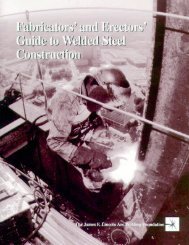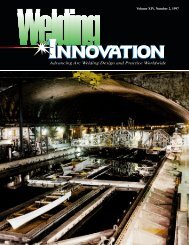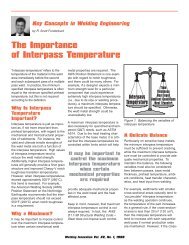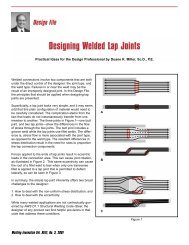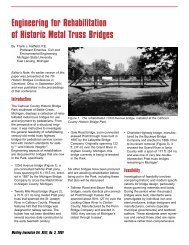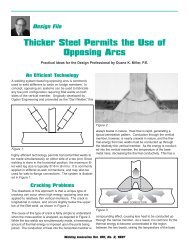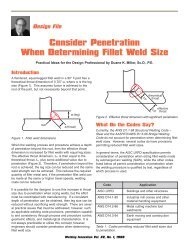The Fall of Skyscrapers
The Fall of Skyscrapers
The Fall of Skyscrapers
You also want an ePaper? Increase the reach of your titles
YUMPU automatically turns print PDFs into web optimized ePapers that Google loves.
<strong>The</strong> <strong>Fall</strong> <strong>of</strong> <strong>Skyscrapers</strong><br />
By Henry Petroski<br />
A.S. Vesic Pr<strong>of</strong>essor <strong>of</strong> Civil Engineering<br />
and Pr<strong>of</strong>essor <strong>of</strong> History<br />
Duke University<br />
Durham, North Carolina<br />
Editor’s Note: This article first<br />
appeared in American Scientist,<br />
Volume 90, January-February 2002.<br />
It is reprinted here with permission.<br />
Copyright, Henry Petroski, 2002.<br />
<strong>The</strong> article is reprinted as written earlier<br />
this year. In the ensuing months,<br />
many investigations have been performed,<br />
and the level <strong>of</strong> understanding<br />
<strong>of</strong> some <strong>of</strong> the technical aspects <strong>of</strong><br />
the World Trade Center collapse have<br />
increased. <strong>The</strong> results <strong>of</strong> the FEMA<br />
investigation discussed in this article<br />
are now available at www.house.gov/<br />
science/hot/wtc/wtcreport.htm<br />
<strong>The</strong> terrorist attacks <strong>of</strong> September 11,<br />
2001, did more than bring down the<br />
World Trade Center towers. <strong>The</strong> collapse<br />
<strong>of</strong> those New York City megastructures,<br />
once the fifth and sixth<br />
tallest buildings in the world, signaled<br />
the beginning <strong>of</strong> a new era in the planning,<br />
design, construction and use <strong>of</strong><br />
skyscrapers . For the foreseeable<br />
future, at least in the West, there are<br />
not likely to be any new super-tall<br />
buildings proposed, and only those<br />
currently under construction will be<br />
added to the skylines <strong>of</strong> the great<br />
cities <strong>of</strong> the world. Even the continued<br />
occupancy <strong>of</strong> signature skyscrapers<br />
may come under scrutiny by their<br />
prime tenants.<br />
Since two hijacked airplanes loaded<br />
with jet fuel were crashed within about<br />
15 minutes <strong>of</strong> each other into the two<br />
most prominent and symbolic structures<br />
<strong>of</strong> lower Manhattan, the once<br />
reassuringly low numbers generated<br />
by probabilistic risk assessment seem<br />
irrelevant. What happened in New York<br />
ceased being a hypothetical, incredible<br />
or ignorable scenario. From now on,<br />
Figure 1. With the collapse <strong>of</strong> the World Trade Center towers, the fate <strong>of</strong> future<br />
skyscraper projects has come into question.<br />
structural engineers must be prepared<br />
to answer harder questions about how<br />
skyscrapers will stand up to the impact<br />
<strong>of</strong> jumbo jets and, perhaps more<br />
important, how they will fare in the<br />
ensuing conflagration. Architects will<br />
likely have to respond more to questions<br />
about stairwells and evacuation<br />
routes than to those about facades<br />
and spires. Because <strong>of</strong> the nature <strong>of</strong><br />
skyscrapers, neither engineers nor<br />
architects will be able to find answers<br />
that will satisfy everyone.<br />
Inclination, Not Economy<br />
Although the idea <strong>of</strong> the skyscraper is<br />
modern, the inclination to build upward<br />
is not. <strong>The</strong> Great Pyramids, with their<br />
broad bases, reached heights unapproached<br />
for the next four millennia.<br />
But even the great Gothic cathedrals,<br />
crafted <strong>of</strong> bulky stone into an aesthetic<br />
<strong>of</strong> lightness and slenderness, are<br />
dwarfed by the steel and reinforced<br />
Welding Innovation Vol. XIX, No. 1, 2002<br />
concrete structures <strong>of</strong> the 20th century.<br />
It was modern building materials<br />
that made the true skyscraper structurally<br />
possible, but it was the mechanical<br />
device <strong>of</strong> the elevator that made<br />
the skyscraper truly practical.<br />
Ironically, it is also the elevator that<br />
has had so much to do with limiting<br />
the height <strong>of</strong> most tall buildings to<br />
about 70 or 80 stories. Above that,<br />
elevator shafts occupy more than 25<br />
percent <strong>of</strong> the volume <strong>of</strong> a tall building,<br />
and so the economics <strong>of</strong> renting out<br />
space argues against investing in<br />
greater height.<br />
<strong>The</strong> World Trade Center towers were<br />
110 stories tall, but even with an elaborate<br />
system <strong>of</strong> local and express elevators,<br />
the associated sky lobbies and<br />
utilities located in the core still<br />
removed almost 30 percent <strong>of</strong> the towers’<br />
floor area from the rentable space<br />
category. By all planning estimates,
the World Trade Center towers should<br />
have been viewed as a poor investment<br />
and so might not have been<br />
undertaken as a strictly private enterprise.<br />
In fact, it was the Port <strong>of</strong> New<br />
York Authority, the bi-state governmental<br />
entity now known as the Port<br />
Authority <strong>of</strong> New York and New Jersey,<br />
that in the 1960s undertook to build<br />
the towers. With its ability to issue<br />
bonds, the Port Authority could afford<br />
to undertake a financially risky project<br />
that few corporations would dare.<br />
Sometimes private enterprise does<br />
engage in similarly questionable<br />
investments, balancing the tangible<br />
financial risk with the intangible gain in<br />
publicity, with the hope that it will<br />
translate ultimately into pr<strong>of</strong>it. This was<br />
the case with the Empire State<br />
Building, completed in 1931 and now<br />
the seventh tallest building in the<br />
world. Although it was not heavily<br />
<strong>The</strong> Port Authority could<br />
undertake a financially risky<br />
project that few corporations<br />
would dare<br />
occupied at first, the cachet <strong>of</strong> the<br />
world’s tallest building made it a prestigious<br />
address and added to its realestate<br />
value. <strong>The</strong> Sears Tower stands<br />
an impressive 110 stories tall, the<br />
same count that the World Trade<br />
Center towers once claimed. This skyscraper<br />
gained for its owner the prestige<br />
<strong>of</strong> having its corporate name<br />
associated with the tallest building in<br />
the world. <strong>The</strong> Sears Tower, completed<br />
in 1974, one year after the second<br />
World Trade Center tower was finished,<br />
held that title for more than 20<br />
years-until the twin Petronas Towers<br />
were completed in Kuala Lumpur,<br />
Malaysia, in 1998, emphasizing the<br />
rise <strong>of</strong> the Far East as the location <strong>of</strong><br />
new megastructures.<br />
Building Innovation<br />
It is not only the innovative use <strong>of</strong> elevators,<br />
marketing and political will that<br />
has enabled super-tall buildings to be<br />
built. A great deal <strong>of</strong> the cost <strong>of</strong> such a<br />
structure is in the amount <strong>of</strong> materials<br />
it contains, so lightening the structure<br />
lowers its cost. Innovative uses <strong>of</strong><br />
building materials can also give a skyscraper<br />
more desirable <strong>of</strong>fice space.<br />
Now more than 70 years old, the steel<br />
frame <strong>of</strong> the Empire State Building has<br />
closely spaced columns, which break<br />
up the floor space and limit <strong>of</strong>fice layouts.<br />
In contrast, the World Trade<br />
Center employed a tubular-construction<br />
principle, in which closely spaced<br />
steel columns were located around the<br />
periphery <strong>of</strong> the building. Sixty-footlong<br />
steel trusses spanned between<br />
these columns and the inner structure<br />
<strong>of</strong> the towers, where further columns<br />
were located, along with the elevator<br />
shafts, stairwells and other non-exclusive<br />
<strong>of</strong>fice space. Between the core<br />
and tube proper, the broad columnless<br />
space enabled open, imaginative<br />
and attractive <strong>of</strong>fice layouts.<br />
<strong>The</strong> tubular concept was not totally<br />
new with the World Trade Center, it<br />
having been used in the diagonally<br />
braced and tapered John Hancock<br />
Center, completed in Chicago in 1969.<br />
<strong>The</strong> Sears Tower is also a tubular<br />
structure, but it consists <strong>of</strong> nine 75-<br />
foot(23-meter)-square tubes bundled<br />
together at the lower stories. <strong>The</strong> varying<br />
heights <strong>of</strong> the tubes give the Sears<br />
Tower an ever-changing look, as it presents<br />
a different pr<strong>of</strong>ile when viewed<br />
from the different directions from<br />
which one approaches it when driving<br />
the city’s expressways. When new to<br />
the Manhattan skyline, the unrelieved<br />
209-foot(64-meter)-square plans and<br />
unbroken 1,360-foot(415-meter)-high<br />
pr<strong>of</strong>iles <strong>of</strong> the twin World Trade Center<br />
buildings came in for considerable<br />
architectural criticism for their lack <strong>of</strong><br />
character. Like the Sears Tower, however,<br />
when viewed from different<br />
angles, the buildings, especially as<br />
they played <strong>of</strong>f against each other,<br />
enjoyed a great aesthetic synergy. <strong>The</strong><br />
view <strong>of</strong> the towers from the walkway <strong>of</strong><br />
the Brooklyn Bridge was especially<br />
striking, with the stark twin monoliths<br />
echoing the twin Gothic arches <strong>of</strong> the<br />
bridge’s towers.<br />
Although the World Trade Center towers<br />
did look like little more than tall<br />
prisms from afar, the play <strong>of</strong> the everchanging<br />
sunlight on their aluminumclad<br />
columns made them new<br />
buildings by the minute. From a closer<br />
perspective, the multiplicity <strong>of</strong> unbroken<br />
columns corseting each building<br />
also gave it an architectural texture.<br />
<strong>The</strong> tubular concept<br />
was not totally new<br />
with the WTC<br />
<strong>The</strong> close spacing <strong>of</strong> the columns was<br />
dictated by the desire to make the<br />
structure as nearly a perfect tube as<br />
possible. A true tube, like a straw,<br />
would be unpunctured by peripheral<br />
openings, but since skyscrapers are<br />
inhabited by people, windows are considered<br />
a psychological must. At the<br />
same time, too-large windows in very<br />
tall buildings can give some occupants<br />
an uneasy feeling. <strong>The</strong> compromise<br />
struck in the World Trade Center was<br />
to use tall but narrow windows<br />
between the steel columns. In fact, the<br />
width <strong>of</strong> the window openings was<br />
said to be less than the width <strong>of</strong> a person’s<br />
shoulders, which was intended<br />
by the designers to provide a measure<br />
<strong>of</strong> reassurance to the occupants.<br />
Since the terrorist attack, however,<br />
one <strong>of</strong> the most haunting images <strong>of</strong><br />
those windows is <strong>of</strong> so many people<br />
standing sideways in the openings,<br />
clinging to the columns and, ultimately,<br />
falling, jumping or being carried to<br />
their death.<br />
Welding Innovation Vol. XIX, No. 1, 2002
Failure Analyses<br />
Terrorists first attempted to bring the<br />
World Trade Center towers down in<br />
1993, when a truck bomb exploded in<br />
the lower-level public garage, at the<br />
base <strong>of</strong> the north tower. Power was<br />
lost in the tower and smoke rose<br />
through it. It was speculated that the<br />
terrorists were attempting to topple the<br />
north tower into the south one, but<br />
even though several floors <strong>of</strong> the<br />
garage were blown out, the structure<br />
stood. <strong>The</strong>re was some concern<br />
among engineers then that the basement<br />
columns, no longer braced by<br />
the garage floors, would buckle, and<br />
so they were fitted with steel bracing<br />
before the recovery work proceeded.<br />
After that attack, access to the underground<br />
garage was severely restricted,<br />
and security in the towers was considerably<br />
increased. No doubt the 1993<br />
bombing was on the minds <strong>of</strong> many<br />
people when the airplanes struck the<br />
towers last September.<br />
As they had in the earlier bombing, the<br />
World Trade Center towers clearly survived<br />
the impact <strong>of</strong> the Boeing 767 airliners.<br />
Given the proven robustness <strong>of</strong><br />
the structures to the earlier bombing<br />
assault, the thought that the buildings<br />
might actually collapse was probably<br />
far from the minds <strong>of</strong> many <strong>of</strong> those<br />
<strong>The</strong> survival <strong>of</strong> the WTC<br />
after the 1993 bombing<br />
seems to have given<br />
an unwarranted sense<br />
<strong>of</strong> security<br />
who were working in them on September<br />
11. It certainly appears not to have<br />
been feared by the police and fire<br />
fighters who rushed in to save people<br />
and extinguish the fires. Indeed, the<br />
survival <strong>of</strong> the World Trade Center<br />
after the 1993 bombing seems to have<br />
given an unwarranted sense <strong>of</strong> security<br />
that the buildings could withstand<br />
even the inferno created by the estimated<br />
20,000 gallons (76,000 liters) <strong>of</strong><br />
jet fuel that each plane carried. (That<br />
amount <strong>of</strong> fuel has been estimated to<br />
have an energy content equivalent to<br />
about 2.4 million sticks <strong>of</strong> dynamite.)<br />
Steel buildings are expected to be firepro<strong>of</strong>ed,<br />
and so the World Trade<br />
Center towers were. However, firepro<strong>of</strong>ing<br />
is a misnomer, for it only insulates<br />
the steel from the heat <strong>of</strong> the fire<br />
for a limited period, which is supposed<br />
to be enough time to allow for the fire<br />
to be brought under control, if not<br />
extinguished entirely. Unfortunately, jet<br />
fuel burns at a much higher temperature<br />
than would a fire fed by normal<br />
construction materials and the customary<br />
furniture and contents found in an<br />
<strong>of</strong>fice building. Furthermore, conventional<br />
fire-fighting means, such as<br />
water, have little effect on burning jet<br />
fuel. <strong>The</strong> World Trade Center fire, estimated<br />
to have produced temperatures<br />
as high as <strong>of</strong> the order <strong>of</strong> the melting<br />
point <strong>of</strong> steel, continued unabated. It<br />
has been speculated that some <strong>of</strong> the<br />
steel beams and columns <strong>of</strong> the structure<br />
that were not destroyed by the<br />
impact eventually may have been<br />
heated close to if not beyond their<br />
melting point, but this appears to have<br />
been unlikely.<br />
Even if it did not melt, the prolonged<br />
elevated temperatures caused the<br />
steel to expand, s<strong>of</strong>ten, sag, bend and<br />
creep. <strong>The</strong> intense heat also caused<br />
the concrete floor, no longer adequately<br />
supported by the steel beams and<br />
columns in place before the impact <strong>of</strong><br />
the airplane, to crack, spall and break<br />
up, compromising the synergistic<br />
action <strong>of</strong> the parts <strong>of</strong> the structure.<br />
Without the stabilizing effect <strong>of</strong> the stiff<br />
floors, the steel columns still intact<br />
became less and less able to sustain<br />
the load <strong>of</strong> the building above them.<br />
When the weight <strong>of</strong> the portion <strong>of</strong> the<br />
building above became too much for<br />
the locally damaged and s<strong>of</strong>tened<br />
structure to withstand, it collapsed<br />
onto the floors below. <strong>The</strong> impact <strong>of</strong><br />
the falling top <strong>of</strong> the building on the<br />
lower floors, whose steel columns<br />
were also s<strong>of</strong>tened by heat transfer<br />
along them, caused them to collapse<br />
in turn, creating an unstoppable chain<br />
reaction. <strong>The</strong> tower that was struck<br />
second failed first in part because the<br />
plane hit lower, leaving a greater<br />
weight to be supported above the<br />
damaged area. (<strong>The</strong> collapse <strong>of</strong> the<br />
lower floors <strong>of</strong> the towers under the<br />
falling weight <strong>of</strong> the upper floors<br />
occurred for the same reason that a<br />
book easily supported on a glass table<br />
can break that same table if dropped<br />
on it from a sufficient height.)<br />
Within days <strong>of</strong> the collapse <strong>of</strong> the towers,<br />
failure analyses appeared on the<br />
Internet and in engineering classrooms.<br />
Perhaps the most widely circulated<br />
were the mechanics-based<br />
analysis <strong>of</strong> Zdenek Bazant <strong>of</strong><br />
Northwestern University and the energy<br />
approach <strong>of</strong> Thomas Mackin <strong>of</strong> the<br />
University <strong>of</strong> Illinois at Urbana-<br />
Champaign. Each <strong>of</strong> these estimated<br />
that the falling upper structure <strong>of</strong> a<br />
World Trade Center tower exerted on<br />
the lower structure a force some 30<br />
times what it had once supported.<br />
Charles Clifton, a New Zealand structural<br />
engineer, argues that the fire was<br />
not the principal cause <strong>of</strong> the collapse.<br />
He thinks that it was the damaged<br />
core rather than the exterior tube<br />
columns that succumbed first to the<br />
enormous load from above. Once the<br />
core support was lost on the impacted<br />
floors, there was no stopping the progressive<br />
collapse, which was largely<br />
channeled by the structural tube to<br />
occur in a vertical direction. In the<br />
wake <strong>of</strong> the World Trade Center disaster,<br />
the immediate concerns were, <strong>of</strong><br />
course, to rescue as many people as<br />
might have survived. Unfortunately,<br />
even to recover most <strong>of</strong> the bodies<br />
proved an ultimately futile effort. <strong>The</strong><br />
twin towers were gigantic structures.<br />
Each floor <strong>of</strong> each building encompassed<br />
an acre, and the towers<br />
enclosed 60 million cubic feet each.<br />
Together, they contained 200,000 tons<br />
<strong>of</strong> steel and 425,000 cubic yards (325<br />
cubic meters) or about 25,000 tons <strong>of</strong><br />
concrete. <strong>The</strong> pile <strong>of</strong> debris in some<br />
places reached as high as a ten-story<br />
building. A month after the terrorist<br />
Welding Innovation Vol. XIX, No. 1, 2002
attack, it was estimated that only 15<br />
percent <strong>of</strong> the debris had been<br />
removed, and it was estimated that it<br />
would take a year to clear the site.<br />
Forensic Engineering<br />
Among the concerns engineers had<br />
about the clean-up operation was how<br />
the removal <strong>of</strong> debris might affect the<br />
stability <strong>of</strong> the ground around the site.<br />
Because the land on which the World<br />
Trade Center was built had been part<br />
<strong>of</strong> the Hudson River, an innovative<br />
barrier had to be developed at the<br />
time <strong>of</strong> construction to prevent river<br />
water from flowing into the basement<br />
<strong>of</strong> the structures. This was done with<br />
the construction <strong>of</strong> a slurry wall, in<br />
which the water was held back by a<br />
deep trench filled with a mudlike mixture<br />
until a hardened concrete barrier<br />
was in place. <strong>The</strong> completed structure<br />
provided a watertight enclosure, which<br />
came to be known as the “bathtub”<br />
within which the World Trade Center<br />
was built. <strong>The</strong> basement floors <strong>of</strong> the<br />
twin towers acted to stabilize the bathtub,<br />
but these were crushed when the<br />
towers broke up and collapsed into the<br />
enclosure. Early indications were that<br />
the bathtub remained intact, but in<br />
order to be sure its walls do not collapse<br />
when the last <strong>of</strong> the debris and<br />
thus all the internal support is<br />
removed, vulnerable sections <strong>of</strong> the<br />
concrete wall were being tied back to<br />
the bedrock under the site even as the<br />
debris removal was proceeding.<br />
Atop the pile <strong>of</strong> debris, the steel<br />
beams and columns were the largest<br />
and most recognizable parts in the<br />
wreckage. <strong>The</strong> concrete, sheetrock<br />
and firepro<strong>of</strong>ing that were in the building<br />
were largely pulverized by the collapsing<br />
structure, as evidenced by the<br />
ubiquitous dust present in the aftermath.<br />
(A significant amount <strong>of</strong><br />
asbestos was apparently used only in<br />
the lower floors <strong>of</strong> one <strong>of</strong> the towers,<br />
bad publicity about the material having<br />
accelerated during the construction <strong>of</strong><br />
the World Trade Center. Nevertheless,<br />
in the days after the collapse, the<br />
All <strong>of</strong> the speculations<br />
about the mechanism<br />
<strong>of</strong> collapse are in fact<br />
hypotheses<br />
once-intolerant Environmental<br />
Protection Agency declared the air<br />
safe.) <strong>The</strong> grille-like remains <strong>of</strong> the<br />
buildings’ facades, towering precariously<br />
over what came to be known as<br />
Ground Zero, became a most eerie<br />
image. Though many argued for leaving<br />
these cathedral wall-like skeletons<br />
standing as memorials to the dead,<br />
they posed a hazard to rescue workers<br />
and were in time torn down and<br />
carted away for possible future reuse<br />
in a reconstructed memorial. As is<br />
<strong>of</strong>ten the case following such a<br />
tragedy, there was also some disagreement<br />
about how to treat the<br />
wreckage generally. Early on, there<br />
was clearly a need to remove as much<br />
<strong>of</strong> it from the site as quickly as possible<br />
so that what survivors there might<br />
be could be uncovered. This necessitated<br />
cutting up steel columns into<br />
sections that could fit on large flatbed<br />
trucks. Even the disposal <strong>of</strong> the wreckage<br />
presented a problem. Much <strong>of</strong> the<br />
steel was marked for immediate recycling,<br />
but forensic engineers worried<br />
that valuable clues to exactly how the<br />
structures collapsed would be lost.<br />
All <strong>of</strong> the speculations <strong>of</strong> engineers<br />
about the mechanism <strong>of</strong> the collapse<br />
are in fact hypotheses, theories <strong>of</strong><br />
what might have happened. Although<br />
computer models will no doubt be constructed<br />
to test those hypotheses and<br />
theories, actual pieces <strong>of</strong> the wreckage<br />
may provide the most convincing<br />
confirmation that the collapse <strong>of</strong> the<br />
structures did in fact progress as<br />
hypothesized. Though the wreckage<br />
may appear to be hopelessly jumbled<br />
and crushed, telltale clues can survive<br />
among the debris. Pieces <strong>of</strong> partially<br />
melted steel, for example, can provide<br />
the means for establishing how hot the<br />
fire burned and where the collapse<br />
might have initiated. Badly bent<br />
columns can give evidence <strong>of</strong> buckling<br />
before and during collapse. Even the<br />
scratches and scars on large pieces <strong>of</strong><br />
steel can be useful in determining the<br />
sequence <strong>of</strong> collapse. This will be the<br />
task <strong>of</strong> teams <strong>of</strong> experts announced<br />
shortly after the tragedy by the<br />
American Society <strong>of</strong> Civil Engineers<br />
and the Federal Emergency<br />
Management Agency. Also in the<br />
immediate wake <strong>of</strong> the collapse, the<br />
National Science Foundation awarded<br />
eight grants to engineering and social<br />
science researchers to assess the<br />
debris as it is being removed and to<br />
study the behavior <strong>of</strong> emergency<br />
response and management teams.<br />
Analyzing the failure <strong>of</strong> the towers is a<br />
Herculean task, but it is important that<br />
engineers understand in detail what<br />
happened so that they incorporate the<br />
lessons learned into future design<br />
practices. It was the careful failure<br />
analysis <strong>of</strong> the bombed Federal<br />
Building in Oklahoma City that led<br />
engineers to delineate guidelines for<br />
designing more terrorist-resistant<br />
buildings. <strong>The</strong> Pentagon was actually<br />
undergoing retr<strong>of</strong>itting to make it better<br />
able to withstand an explosion when it<br />
was hit by a third hijacked plane on<br />
September 11. Part <strong>of</strong> the section <strong>of</strong><br />
the building that was struck had in fact<br />
just been strengthened, and it suffered<br />
much less damage than the old section<br />
beside it, thus demonstrating the<br />
effectiveness <strong>of</strong> the work.<br />
Understanding how the World Trade<br />
Center towers collapsed will enable<br />
engineers to build more attack-resistant<br />
skyscrapers. Even before a<br />
detailed failure analysis is completed,<br />
however, it is evident that one way to<br />
minimize the damage to tall structures<br />
is to prevent airplanes and their fuel<br />
from being able to penetrate deeply<br />
into the buildings in the first place.<br />
This is not an impossible task. When a<br />
B-25 bomber struck the Empire State<br />
Welding Innovation Vol. XIX, No. 1, 2002
Building in 1945, its body stuck out<br />
from the 78th and 79th floors like a<br />
long car in a short garage. <strong>The</strong> building<br />
suffered an 18-by-20-foot (5.5-by-<br />
6-meter) hole in its face, but there was<br />
no conflagration, and there certainly<br />
was no collapse. <strong>The</strong> greatest damage<br />
was done by the engines coming<br />
loose and flying like missiles through<br />
the building. <strong>The</strong> wreckage <strong>of</strong> the<br />
plane was removed, the local damage<br />
repaired and the building restored to<br />
its original state. Among the differences<br />
between the Empire State<br />
Building and World Trade Center incidents<br />
was that in the former case, relatively<br />
speaking, a lighter plane struck<br />
a heavier structure. Furthermore, the<br />
propeller-driven bomber was on a<br />
short-range flight from Bedford,<br />
Massachusetts to Newark airport and<br />
<strong>The</strong> towers might have stood<br />
after the attack if the fires had<br />
been extinguished quickly<br />
so did not have on board the amount<br />
<strong>of</strong> fuel necessary to complete a<br />
transcontinental flight or to bring down<br />
a skyscraper.<br />
Modern tall buildings can be strengthened<br />
to be more resistant to full penetration<br />
by even the heaviest <strong>of</strong> aircraft.<br />
This can be done by placing more and<br />
heavier columns around the periphery<br />
<strong>of</strong> the structure, making the tube<br />
denser and thicker, as it were. <strong>The</strong> ultimate<br />
defense would be to make the<br />
facade a solid wall <strong>of</strong> steel or concrete,<br />
or both. This would eliminate windows<br />
entirely, <strong>of</strong> course, which would defeat<br />
some <strong>of</strong> the purpose <strong>of</strong> a skyscraper,<br />
which is in part to provide a dramatic<br />
view from a prestigious <strong>of</strong>fice or board<br />
room. <strong>The</strong> elimination <strong>of</strong> that attraction,<br />
in conjunction with the increased mass<br />
<strong>of</strong> the structure itself, would provide<br />
space that would command a significantly<br />
lower rent and yet cost a great<br />
deal more to build. Indeed, no one<br />
would likely even consider building or<br />
Courtesy <strong>of</strong> American Scientist<br />
Figure 2. Structural design <strong>of</strong> the<br />
World Trade Center towers was a tube<br />
with a central core.<br />
renting space in such a building.<br />
Hence, the solution would be a Pyrrhic<br />
victory over terrorists.<br />
<strong>The</strong> World Trade Center towers might<br />
have stood after the terrorist attack if<br />
the fires had been extinguished quickly.<br />
But even if the conventional sprinkler<br />
systems had not been damaged,<br />
water would not have been effective<br />
against the burning jet fuel. Perhaps<br />
skyscrapers could be fitted with a<br />
robust fire-fighting system employing<br />
the kind <strong>of</strong> foam that is laid down on<br />
airport runways during emergency<br />
landings, or fitted with some other oxygen-depriving<br />
scheme, if there could<br />
also be a way for fleeing people to<br />
breathe in such an environment. Such<br />
schemes would need robustness and<br />
redundancy to survive tremendous<br />
impact forces, so any such system<br />
might be unattractively bulky and prohibitively<br />
expensive to install. Other<br />
approaches might include more effective<br />
firepro<strong>of</strong>ing, such as employing<br />
ceramic-based materials, thus at least<br />
giving the occupants <strong>of</strong> a burning<br />
building more time to evacuate.<br />
<strong>The</strong> evacuation <strong>of</strong> tall buildings will no<br />
doubt now be given much more attention<br />
by architects and engineers alike.<br />
Each World Trade Center tower had<br />
multiple stairways, but all were in the<br />
single central core <strong>of</strong> the building. In<br />
contrast, stairways in Germany, for<br />
example, are required to be in different<br />
corners <strong>of</strong> the building. In that configuration,<br />
it is much more likely that one<br />
stairway will remain open even if a<br />
plane crashes into another corner. But<br />
locating stairwells in the corners <strong>of</strong> a<br />
building means, <strong>of</strong> course, that prime<br />
<strong>of</strong>fice space cannot be located there.<br />
In other words, most measures to<br />
make buildings safer also make them<br />
more expensive to build and diminish<br />
the appeal <strong>of</strong> their <strong>of</strong>fice space. This<br />
dilemma is at the heart <strong>of</strong> the reason<br />
why the future <strong>of</strong> the skyscraper is<br />
threatened.<br />
It is likely that, in the wake <strong>of</strong> the<br />
World Trade Center collapses, any<br />
super-tall building currently in the<br />
development stage will be put on hold<br />
and reconsidered. Real-estate<br />
investors will want to know how the<br />
proposed building will stand up to the<br />
crash <strong>of</strong> a fully fueled jumbo jet, how<br />
hot the ensuing fire will burn, how long<br />
it will take to be extinguished and how<br />
long the building will stand so that the<br />
occupants can evacuate. <strong>The</strong> investors<br />
will also want to know who will rent the<br />
space if it is built.<br />
Potential tenants will have the same<br />
questions about terrorist attacks.<br />
Companies will also wonder if their<br />
employees will be willing to work on<br />
the upper stories <strong>of</strong> a tall building.<br />
Managers will wonder if those employees<br />
who do agree to work in the building<br />
will be constantly distracted,<br />
watching out the window for approaching<br />
airplanes. Corporations will wonder<br />
if clients will be reluctant to come to a<br />
place <strong>of</strong> business perceived to be vulnerable<br />
to attack. <strong>The</strong> very need to<br />
have workers grouped together on<br />
adjacent floors in tall buildings is also<br />
being called into question.<br />
After the events <strong>of</strong> September 11, the<br />
incentive to build a signature structure,<br />
a distinctive super-tall building that<br />
sticks out in the skyline, is greatly<br />
diminished. In the immediate future, as<br />
leases come up for renewal in existing<br />
skyscrapers, real-estate investors will<br />
be watching closely for trends. It is<br />
unlikely that our most familiar skylines<br />
will be greatly changed in the foreseeable<br />
future. Indeed, if companies begin<br />
Welding Innovation Vol. XIX, No. 1, 2002
to move their operations wholesale out<br />
<strong>of</strong> the most distinctive and iconic <strong>of</strong><br />
super-tall buildings and into more nondescript<br />
structures <strong>of</strong> moderate height,<br />
it is not unimaginable that cities like<br />
New York and Chicago will in time see<br />
the reversal <strong>of</strong> a long-standing trend.<br />
We might expect no longer to see<br />
developers buying up land, demolishing<br />
the low-rise buildings on it, and<br />
putting up a new skyscraper. Instead,<br />
owners might be more likely to demolish<br />
a vacant skyscraper and erect in<br />
its place a building that is not significantly<br />
smaller or taller than its neighbors.<br />
Skylines that were once<br />
immediately recognizable even in silhouette<br />
for their peaks and valleys<br />
may someday be as flat as a mesa.<br />
<strong>The</strong>re is no imperative to such an<br />
interplay between technology and<br />
society. What really happens in the<br />
coming years will depend largely on<br />
how businesses, governments and<br />
individuals react to terrorism and the<br />
threat <strong>of</strong> terrorism. Unfortunately, the<br />
image <strong>of</strong> the World Trade Center towers<br />
collapsing will remain in our collective<br />
consciousness for a few<br />
Skylines once recognizable in<br />
silhouette may someday be as<br />
flat as a mesa<br />
generations, at least. Thus, it is no idle<br />
speculation to think that it will be at<br />
least a generation before skyscrapers<br />
return to ascendancy, if they ever do.<br />
Developments in micro-miniaturization,<br />
telecommunications, information technology,<br />
business practice, management<br />
science, economics, psychology<br />
and politics will likely play a much larger<br />
role than architecture and engineering<br />
in determining the immediate<br />
future <strong>of</strong> macro-structures, at least in<br />
the West.<br />
Bibliography<br />
Bazant, Zdenek P., and Youg Zhou. 2001. “Why<br />
did the World Trade Center collapse?-Simple<br />
analysis.” Journal <strong>of</strong> Engineering Mechanics,<br />
vol. 128 (2002) pp 2-6. www3.tam.uiuc.edu/<br />
news/200109 c/<br />
Clifton, G. Charles. 2001. Collapse <strong>of</strong> the World<br />
Trade Center towers. www.hera.org.nz/pdf<br />
files/worldtrade centre.pdf<br />
Mackin, Thomas J. 2001. Engineering analysis<br />
<strong>of</strong> tragedy at WTC. Presentation slides for ME<br />
346, Department <strong>of</strong> Mechanical Engineering,<br />
University <strong>of</strong> Illinois at Urbana-Champaign.<br />
Welding Innovation Vol. XIX, No. 1, 2002





